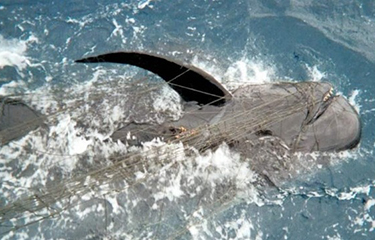New federal law phases out large-mesh drift gillnets for California swordfish

Large-mesh drift gillnets used in the swordfish fishery in the U.S. state of California have faced scrutiny from government regulators and environmental groups for historically high bycatch rates for years. Now, with the passage of the federal Driftnet Modernization and Bycatch Reduction Act, the gear type is set to be phased out over the next five years.
The act was passed as part of the USD 1.7 trillion (EUR 1.5 trillion) federal omnibus spending bill signed into law by U.S. President Joe Biden in the final days of 2022.
A federal ban was first passed by both chambers of Congress as a standalone bill in 2020, but was subject to the final veto of Donald Trump’s presidency. The bill was reintroduced by U.S. Sen. Diane Feinstein (D-California) in 2021, and was included in the 4,155-page spending bill that will finance the federal government through September 2023.
The legislation also includes grants to the remaining large-drift gillnet permit holders to cover the cost of permits, the forfeiture of existing fishing gear, and the acquisition of alternative fishing gear, according to the Congressional Budget Office.
The use of large-mesh drift gillnets has been on the decline for decades, peaking in 1988 and 1989 with 10,000 sets made each year by more than 200 active permit holders, according to NOAA Fisheries. But in the 2020-2021 and 2021-2022 season just seven large-mesh drift gillnet permits – out of a total of 25 federal permits – were active. Large-mesh drift gillnets are only allowed off the coast of California and Oregon, and are prohibited everywhere else in U.S. waters over environmental concerns.
“Swordfish should have been the third-biggest produc[ing] [fishery] in California behind squid and Dungeness crabs,” said Gary Burke of Santa Barbara, California, who has fished for swordfish with large-mesh drift gillnets since the 1980s and has remained one of the most vocal defenders of the fishery in the state.
But seeing the writing on the wall even before the federal phase-out was on the books, 38 California commercial fishermen retired their gillnets with a state buy-out plan, with many switching to deep-set buoy gear using single lines with baited hooks.
In 2018, the California legislature voted to terminate all drift gillnet permits by 31 January, 2024. The bill also established a transition program to help fishermen mitigate transition costs and develop new techniques to efficiently harvest swordfish efficiently with less bycatch.
All told, USD 2.3 million (EUR 2.1 million) in state funds and USD 1 million (EUR 930,000) provided by Oceana, an environmental nonprofit, have helped remove 50 miles and 54 tons of gillnets from the Pacific.
U.S. West Coast large-mesh drift gillnets, around a mile in length, are set around dusk and hung at 200 feet below the ocean surface for up to 12 to 14 hours.
Before widespread use of the gillnets, swordfish were harvested almost exclusively with harpoon in waters off the coast of California until 1980. But the fisheries proved to be hit-or-miss, with fishermen only able to harpoon swordfish at times when they were basking. So, fisherman began using large-mesh drift gillnets for a more-predictable catch, at which time the state of California began issuing permits.
High bycatch rates of whales, sea turtles, and other marine mammals lead to California voters passing a ballot measure to ban large-mesh drift gillnets in state waters in 1990, and lead to the creation of the federal take reduction team in 1996.
The fishery came under federal management in 2004 through the Pacific Fishery Management Council’s Highly Migratory Species Plan, but it wasn’t until 2018 that NOAA Fisheries issued federal permits to state permit holders.
Data from fishery observers during the 2021-2022 season showed the swordfish drift gillnet fleet discarded 45 percent of the total catch as non-targeted species, according to Oceana. In contrast, deep-set buoy gear caught four times more swordfish without that incidental capture of protected species, the group said.
“Fishing with deep-set buoy gear is a proven way to catch swordfish without harming other animals and leads to higher quality swordfish that bring better prices for fishermen,” Oceana California Campaign Director and Senior Scientist Geoff Shester said. “Deep-set buoy gear is the future of swordfish fishing here in California and a win-win for fishermen and the oceans.”
While the 2018 California law terminates state large-mesh drift gillnet permits by 2024 and required those accepting the buyout to rescind their federal permits, drift gillnetting would have been permitted for the 25 permit-holders in federal waters off the coast of California in absence of the 2021 ban on large-mesh drift gillnets in U.S. fisheries by 2027.
Reporting by Nick Rahaim
Photo courtesy of NOAA Fisheries






Share